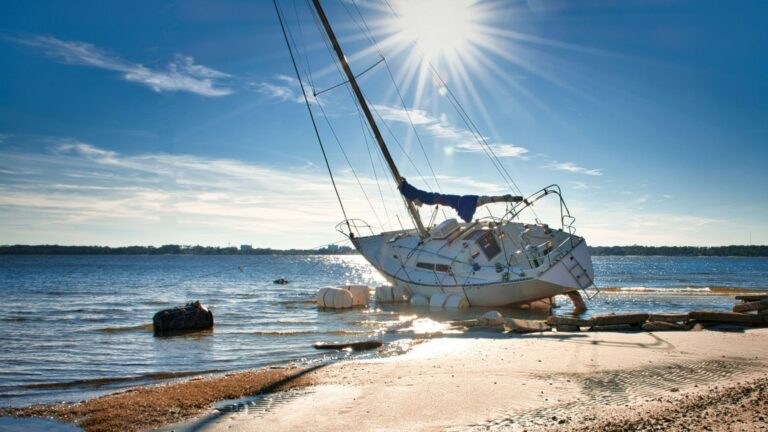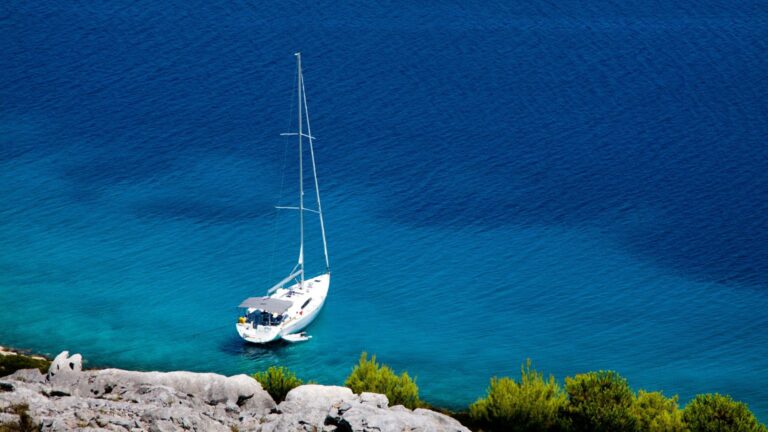The material used in building a sailboat significantly influences its performance, durability, maintenance, weight, cost, and aesthetics. Over the decades, boat builders have experimented with various materials—from traditional wood to modern composites.
Here we explore the most common materials used in sailboat construction: steel, aluminum, fiberglass (glass-reinforced plastic), wood, and ferrocement. Each has distinct characteristics, making it more or less suitable depending on intended use and owner’s priorities.
Choosing the right material for a sailboat hull is one of the most important decisions a sailor or boatbuilder can make. Each material—whether traditional or modern—offers a unique balance of durability, maintenance requirements, cost, and sailing performance.
Steel
Steel has long been a favorite material for building rugged, ocean-going yachts—particularly among sailors with ambitions of global circumnavigation or high-latitude expeditions. Its reputation for strength and resilience under extreme conditions makes it a top choice for vessels that must endure the harshest marine environments. However, steel is not without its challenges, especially when it comes to corrosion and weight. Let’s examine what makes steel such a reliable material—and where it might fall short.
Advantages
- Exceptional Strength: Steel is highly resistant to impact damage, making it ideal for ocean-going boats that might encounter ice, floating debris, or grounding.
- Repairability: Steel is easy to weld and repair anywhere in the world, making it a favorite for bluewater cruisers.
- Cost-effective for Large Builds: For boats over 40 feet, steel can be more economical than fiberglass or aluminum.
Disadvantages
- Corrosion: Steel rusts quickly if not properly maintained, especially in saltwater environments. Requires rigorous and ongoing protection (painting, sandblasting, epoxy coating).
- Weight: Heavier than other materials, which can reduce sailing performance and speed.
- Thermal Conductivity: Poor insulation characteristics—can be hot in the sun and cold in cold weather.
Best For: Long-distance cruisers and expedition yachts where durability and repairability matter more than speed.
Aluminum
Aluminum is a premium material that combines strength with lightness, offering excellent resistance to corrosion and minimal maintenance demands when properly constructed. It’s often the go-to material for high-performance cruisers and expedition yachts heading to remote or icy regions. Despite its many advantages, aluminum requires skilled workmanship and can be expensive to build and repair. In this section, we’ll explore how aluminum performs in real-world sailing and whether it’s worth the investment.
Advantages
- Lightweight & Strong: Aluminum offers a great strength-to-weight ratio, ideal for performance cruisers and racing sailboats.
- Corrosion Resistance: Especially if marine-grade alloys (e.g., 5083 or 5086) are used and properly maintained.
- No Rust: Unlike steel, aluminum doesn’t rust (although it can suffer galvanic corrosion if dissimilar metals are present).
Disadvantages
- Cost: More expensive than steel or fiberglass, both in materials and fabrication.
- Specialized Repairs: Welding aluminum requires specific tools and skills, not always available in remote areas.
- Electrolysis Risk: Prone to galvanic corrosion if electrical systems aren’t properly bonded and isolated.
Best For: Lightweight expedition yachts, performance cruisers, and sailors exploring remote areas who value strength without the weight penalty.
Fiberglass (Glass-Reinforced Plastic, GRP)
Fiberglass revolutionized the boatbuilding industry in the 20th century and remains the most popular choice for sailboats today. Its moldability, cost efficiency, and low maintenance appeal to manufacturers and recreational sailors alike. Most production sailboats, especially those under 50 feet, are built from fiberglass.
But while GRP boats are accessible and long-lasting, they are not entirely without weaknesses. Here’s what you need to know about the advantages—and potential issues—of fiberglass hulls.
Advantages
- Low Maintenance: Doesn’t rust or rot. Needs occasional polishing and minor gelcoat repairs.
- Mass Production Friendly: Ideal for molded production boats, keeping costs lower.
- Long-lasting: Properly built fiberglass hulls can last for decades with minimal structural degradation.
- Good Insulation: More thermally stable than metal boats.
Disadvantages
- Osmotic Blistering: Some older hulls suffer from water intrusion through the gelcoat, leading to blisters.
- Delamination Risk: Poor construction can lead to separation of layers.
- Heavy for its Strength: Compared to aluminum or advanced composites, fiberglass is heavier for the same strength.
Best For: Coastal cruisers, weekend sailors, and most modern production yachts.
Wood
Wood is the oldest material used in boat construction, revered for its beauty, buoyancy, and timeless charm. For centuries, master craftsmen have shaped wooden hulls that were both functional and stunning. While modern techniques have improved wooden boat longevity, this material still demands high maintenance and hands-on care.
If you’re drawn to traditional aesthetics and don’t mind getting your hands dirty, wood might be the right choice. Let’s take a deeper look into its characteristics.
Advantages
- Aesthetic Appeal: Beautiful, warm, and classic look; many owners love the craftsmanship involved.
- Buoyancy: Naturally buoyant and, if built well, can be very seaworthy.
- Ease of Working: Easy to repair with basic tools and skills, especially in developing regions.
Disadvantages
- High Maintenance: Requires constant upkeep to prevent rot, especially in tropical climates.
- Durability: More susceptible to insects, marine borers, and water damage than synthetic materials.
- Labor-Intensive Build: Requires skilled craftsmen and longer build times.
Best For: Enthusiasts of classic boats, small boat builders, and restoration projects.
Ferrocement
(Concrete reinforced with steel mesh) Ferrocement—essentially a steel-reinforced concrete hull—emerged as a low-cost alternative for amateur boatbuilders in the mid-20th century. Though it has a poor reputation today due to many badly executed DIY projects, a well-built ferrocement boat can be incredibly strong and durable.
However, its heavy weight and limited resale value make it a niche option. This section explores the realities of ferrocement construction: its benefits, common myths, and whether it still has a place in modern yacht building.
Advantages
- Very Low Cost: One of the cheapest materials for building a large hull.
- Fireproof & Durable: Resistant to fire, rot, and marine growth.
- Strong When Built Properly: Some ferrocement boats have crossed oceans successfully.
Disadvantages
- Heavy: Extremely heavy hulls that lack performance.
- Reputation for DIY Failures: Many ferrocement boats were amateur-built with poor craftsmanship.
- Difficult to Sell: Due to stigma and maintenance issues, resale value is usually low.
Best For: Budget-minded long-term cruisers willing to trade performance for economy.
Comparison Table
| Material | Strength | Weight | Maintenance | Cost | Repairability | Longevity | Common Use |
|---|---|---|---|---|---|---|---|
| Steel | ★★★★★ | ★★☆☆☆ | ★☆☆☆☆ | ★★★★☆ | ★★★★★ | ★★★★☆ | Ocean cruising, custom builds |
| Aluminum | ★★★★☆ | ★★★★☆ | ★★★☆☆ | ★★☆☆☆ | ★★☆☆☆ | ★★★★☆ | High-end cruisers, racers |
| Fiberglass | ★★★☆☆ | ★★★☆☆ | ★★★★☆ | ★★★★☆ | ★★★☆☆ | ★★★★☆ | Production boats, cruisers |
| Wood | ★★☆☆☆ | ★★★☆☆ | ★☆☆☆☆ | ★★☆☆☆ | ★★★★☆ | ★★☆☆☆ | Classics, custom lovers |
| Ferrocement | ★★★☆☆ | ★☆☆☆☆ | ★★☆☆☆ | ★★★★★ | ★★★☆☆ | ★★★☆☆ | Budget cruisers |
Which Material Should You Choose?
The “best” material depends on your sailing style, budget, and willingness to maintain the boat.
Choose Fiberglass if…
You want a reliable, easy-to-maintain cruiser for coastal or offshore passages. It’s the standard choice for most sailors.
Choose Aluminum if…
You prioritize performance and strength in a lightweight hull, and you’re venturing into remote or icy waters.
Choose Steel if…
Durability and easy repair matter most, especially for global circumnavigation on a budget—but you’re willing to invest time in rust prevention.
Choose Wood if…
You love craftsmanship and tradition, and are prepared for hands-on maintenance.
Choose Ferrocement if…
You’re building on a very tight budget and are focused more on living aboard than fast sailing.
Conclusion
While fiberglass remains the most popular and versatile material for modern sailboats, there are valid reasons to choose other materials based on your sailing ambitions. Whether you’re racing, cruising the Arctic, or restoring a vintage wooden sloop, understanding the pros and cons of each material ensures your boat is not just a vessel—but the right partner for your adventures at sea.




